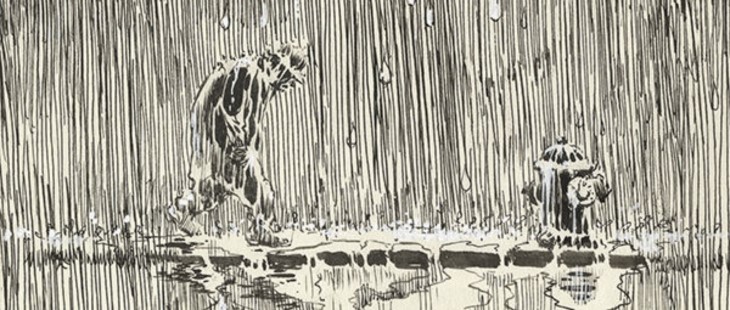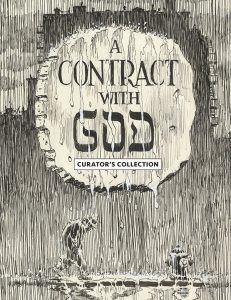A Contract with God and Other Tenement Stories: Curator’s Collection
Will Eisner
John Lind (editing and design)
Kitchen Sink Books, an imprint of Dark Horse Comics
May 30, 2018
A Contract with God and Other Tenement Stories: Curator’s Collection offers two volumes, showcasing Will Eisner’s celebrated artistry. The first volume gathers his sketches and pencil work, and the second volume contains meticulously reproduced photocopies of each page of his original inks, with the page edges and bordering notes preserved.
It does seem appropriate that such a celebratory edition should be given to this text, not only because of the status of the book itself, but also because of the importance of its author. Will Eisner, creator of The Spirit as well as many graphic novels over the long decades of his illustrious career, is one of the luminaries of the comics field. The annual Will Eisner Comic Industry Awards, considered the “Oscars” of the comics world, are named for him.
The impetus for this luxe edition, which retails at almost 200 dollars, is summed up in Eisner Award winner Vivek J. Tiwary’s quoted “appreciation” in the first volume: that “every page in A Contract with God is a master class in the mechanics of comics,” and that as five-time Eisner Award winner Stan Sakai says on the very same page, Eisner “was a master of stories with a soul, and he showed us how to do it right.”
A Contract With God is a collection of four short stories set in the 1930s with their locus being one building in the Bronx. As Dave Gibbons puts it in “A Tenament Testament,” an essay which introduces the volume of original inks, “although lauded, unnecessarily, as the first graphic novel, A Contract with God is better described as a collection of stories, loosely related by their setting—essentially vignettes of urban life”.
In the titular first story, readers are introduced to Frimme Hersh, whose daughter has died “in her sixteenth year.” He believes this is a betrayal from God. As Denis Kitchen notes in his discussion of this edition, “when A Contract with God was first published, and for many years afterward, no one outside the Eisner family and their close friends knew the painful autobiographical tie-in to this central story. Will and Ann Eisner’s only daughter, Alice, died of leukemia at age sixteen, less than a decade before A Contract with God was published.”
The other stories in A Contract with God are also poignant, to the point that they could feel maudlin to a first time contemporary reader—especially since so many of them include violence against women. But this deluxe two-volume edition is not for a first-time contemporary reader. It is, rather, for readers who already know these stories well, and wish to savor the artistry that went into the creation of the antiheroes they feature.
Gibbons’s essay in this collection asserts that “The triumph of A Contract with God lies in its honesty and open-heartedness,” and while all four stories feature men who feel hard done by, behaving badly while nagged by women, the openheartedness Gibbons mentions is most apparent in the final story, “Cookalein.” It opens up the world of the collection to many more locations, swirling around the relief and the feeling of potential inherent in escaping the Bronx tenement for the summer.
Reading the volume of pencil drafts is surprisingly easy. Though the pages are sketchy and contain obvious layers of drafts, they are all legible. I could certainly envision a contemporary book being published with this aesthetic as its final form.
Reading the volume of original inks, however, is a much more satisfying experience. It feels sumptuous because of the fine quality of the reproduced ink work, and intimate in the way that single-creator comics are, since the writing, layouts, pictures, lettering and shading are all done by the same hand.
The reproduced paper quality and borders serve to make the volume of inks feel immediate, as though we are seeing the actual pages Eisner worked on when the ink was still wet. Two different essays included in this edition emphasize the fact that Eisner worked at a similar scale to the printed volume, also increasing a sense of intimacy and immediacy as well as veneration. The wide borders, careful attention to hand-lettering, and the fact that Eisner worked on vellum for the inks, all serve to make the experience of reading Volume 2 of this edition feel like reading a medieval manuscript.
Such a luxe edition seems appropriate for a work that has been so foundational in the field. As attested by the various Eisner Award winners whose “appreciations” are interspersed throughout the pages of these volumes, Eisner’s work on this book was groundbreaking in terms of his story creation and page design, with innovative paneling and layouts that could flow clearly without the use of panels.
A weak point, though not a dealbreaker, is Frank Miller’s introduction to the first volume. It is one of the longest of the many prose introductions and “appreciations” included in the Curator’s Collection, and in fact, Dark Horse’s first Curator’s Collection edition, in 2016, was an edition of Frank Miller’s Sin City: The Hard Goodbye. In his intro, Miller puts his own work in the same category as Eisner’s, compares A Contract with God, apparently un-ironically, to a Christmas movie, and declares that “lettering is not really much of an instrument of expression,” while praising Eisner’s distinctive lettering. None of that was particularly to my taste.
Luckily, the other essays and blurbs included in this edition are more informative, especially those by John Lind and, unsurprisingly, those by Will Eisner himself.
With the emphasis on preserving the physicality of the paper Eisner worked on, coupled with the inherent juxtaposition of the volume of sketchy page drafts complete with blue pencil alongside the rich and comparatively polished inks of the other volume, this Curator’s Collection rides the line between veneration object and practical coursework in the craft. The essays, introductions, afterwords and “appreciations” written by experts in the field peppered throughout the two volumes make this dual purpose of the edition clear.
This price point of the Curator’s Collection means that it is not for casual ownership. If you have access to a wealthy library system, however, try to get your library to buy it. It’s pretty to look at, and educational to study.


